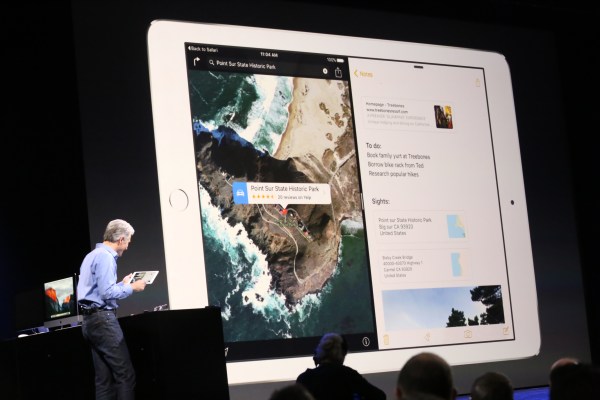Apple is encouraging developers to stop thinking about their user interfaces in terms of specific devices and orientation, and to start thinking in terms of different view types, in the interest of building interfaces that work with the multitasking mode introduced for using apps side-by-side on iPad in iOS 9.
The changes reflect the best example of Apple’s tendency to ‘telegraph’ future product announcements with changes to development tools and frameworks, however, laying the groundwork for the much-discussed larger iPad Pro supposedly coming later this year – and other devices not yet announced.
Previous versions of Apple’s developer tools encouraged those building apps to think in terms of interface orientation, with portrait and landscape acting as the primary situators. The new way of thinking favours ‘compact’ and ‘regular’ width views, with compact being what we’d traditionally associate with an iPhone portrait look, for instance, and regular looking like larger Apple devices, including the iPhone 6 Plus and iPad, in landscape (often displaying multiple columns at once).
Rather than being tied to devices, however, this new method allows for side-by-side views on iPad, including the one-third slide over mode, where an app has a single column that takes up just a small portion of the iPad’s overall screen, or split view, where it’s taking up a full half of the available real estate. In the new paradigm, it’s not about devices or which way the display is oriented; it’s about how a user has selected to view apps on the same display in multitasking mode.
This is significant because, like Apple’s attempts to encourage developers to get on board with adaptive user interfaces last year in preparation for the then-unannounced iPhone 6 and 6 Plus, this seems to be Apple subtly saying that developers should expect to see more in the way of split displays in future iOS devices.
The iPad Air 2 is currently the only application that supports true split view, multi-app interactivity (others let you peek at secondary apps without interacting with both simultaneously). But it’s clear that future generations of iPad will likely support this across devices, including likely on an updated iPad mini with an improved processor. The rumoured iPad Pro is also a prime candidate for this type of interface, given its likely focus on work and productivity applications.
I’d go even further and suggest that Apple might be thinking long-term about how this could apply broadly to all iOS devices – the 6 Plus already behaves a lot like an iPad when used in landscape mode, for instance, and it’s not hard to envision it supporting a split-screen interface given the flexibility of a single-column vertical scroll mechanism for apps like iMessage or Notes.
Some developers I’ve spoken to say that while the change in thinking seems a little daunting at first, modifying iPad apps to take advantage of the new multi-tasking powers in iOS 9 actually shouldn’t be that difficult. And Apple’s making it clear this time – doing so will reap benefits long-term in terms of addressing unannounced hardware platform that may appear in the future.
